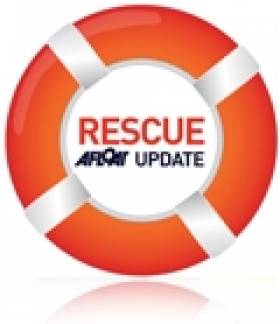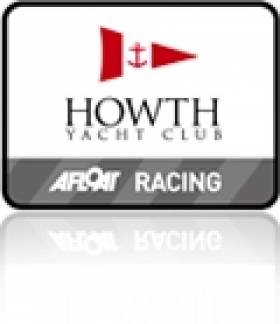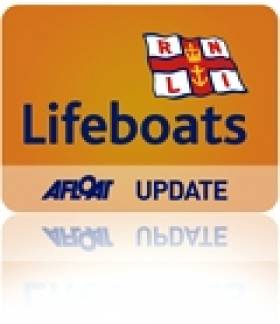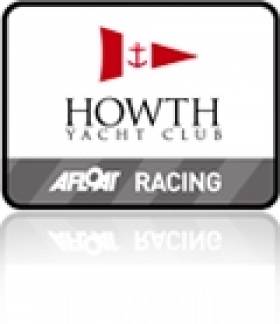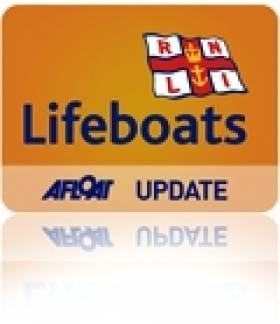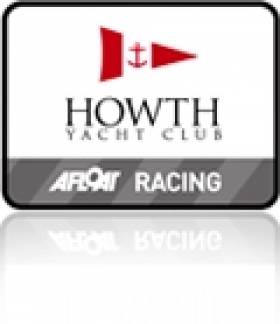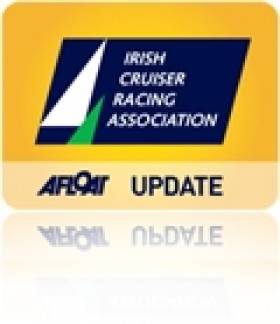Displaying items by tag: Howth
Teen Rescued From Howth Cliff Edge
#Rescue - TheJournal.ie reports that 15 members of the Irish Coast Guard's Cliff Rescue Unit were involved in the rescue of a 16-year-old boy trapped on a cliff edge on Howth Head in North Dublin on Saturday evening (6 July).
According to Howth Coast Guard, the teen had tried to climb up from the beach at Whitewater Brook but became stranded halfway up the cliff face.
Coastguard staff received the emergency call around 9.40pm and the rescue unit was on scene within 10 minutes. The teen was quickly recovered to the cliff top with no reported injuries.
Whitewater Brook was recently the scene of a joint cliff rescue training exercise involving the Howth Coast Guard and the Irish Red Cross.
Howth Yacht Club (HYC) Race Results for Tuesday, 25th June
17 scr
,Deilginis,Deilginis Group
2,Oona,P Courtney
3,Leila,R Cooper
17 Hcap
1,Deilginis,Deilginis Group
2,Leila,R Cooper
3,Oona,P Courtney
Puppeteer Scr
1,Harlequin,Clarke/Egan
2,Trick or Treat,A Pearson
3,Gold Dust,Walls/Browne
Puppeteer Hcap
1,Trick or Treat,A Pearson
2,Gannet,T Chillingworth
3,Harlequin,Clarke/Egan
Squib Scr
1,Selik,F O'Kelly
2,Puffin,Emer Harte
3,Fantome,R MacDonell
Squib HPH
1,Puffin,Emer Harte
2,Selik,F O'Kelly
3,Fantome,R MacDonell
Howth Yacht Club (HYC) Results for Wed, 12th June 2013
Class 3 IRC
1,Hard on Port,F O'Driscoll
2,Kilcullen Euro Car Parks,HYC K25 Team
3,Starlet,Bourke/Others
Class 3 HPH
1,Starlet,Bourke/Others
2,Stage Fright,Wormald/Walsh
3,Helly Hunter,L McMurtry
White Sail IRC
1,Bite the Bullet,C Bermingham
2,Jokers Wild,G Knaggs
3,Brazen Hussy,Barry/Stirling
White Sail HPH
1,Jokers Wild,G Knaggs
2,Brazen Hussy,Barry/Stirling
3,Bite the Bullet,C Bermingham
Dog Rescued After Dramatic 200ft Cliff Fall at Howth Head
#rnli – Howth RNLI rescued a dog after he fell 200 feet from a cliff in north county Dublin yesterday.
The alarm was raised at approximately 4.30pm by a member of the public who was walking along the cliff path at Howth Head and noticed the dog's distressed owners.
The lifeboat helmed by Dave Howard and with fellow volunteer crew members Lorcan Dignam and Darryl Reamsbottom on board, was launched within minutes and went to the scene where the crew observed that Luca, a Pointer had fallen from the highest point of the cliff at the nose of Howth.
In what was a challenging rescue lasting about 30 minutes, two of the lifeboat crew with the guidance of Luca's owners at the top of the cliff, climbed over rocks and made their way to the frightened animal.
Having successfully recovered Luca, the crew then had to carefully work their way back to the lifeboat through the rocky boulders.
While returning to the lifeboat station, the inshore lifeboat crew came across a broken down jet-ski. The lifeboat towed the vessel and its owner safely back to a slipway at Howth Harbour.
Speaking following the call out, Howth RNLI Helm Dave Howard said: 'This was one very lucky dog. It was a 200ft drop and we didn't expect to have such a happy outcome to this rescue. Needless to say the owners were delighted to have Luca who was frightened and shivering but without harm, safely returned to them'.
This was the first of two call outs for Howth RNLI yesterday. The second came at 5.40pm when the lifeboat was requested to launch again following a report that a man who had been swimming across the channel to Malahide had got into difficulty.
The inshore lifeboat helmed this time by Lorcan Dignam and with crew members Tim McDonnell and Joss Walsh on board made its way to the scene where the swimmers having being dragged to shore by two friends who had raised the alarm, was located on the south eastern tip of Donabate Strand.
The lifeboat crew assessed the man and administered first aid on the scene before he was airlifted to hospital by the Irish Coast Guard
J24 Yacht Wins Howth's Lambay Race (Results Here!)
#lambayrace – Rarely have Lambay race competitors at Howth Yacht Club crossed the start and finish lines wearing shorts! The 2013 Lambay Races were bathed from start to finish in glorious sunshine and a light north-easterly breeze. Over 120 boats competed and boat of the day was "Hard on Port", a J24 which showed a clean pair of heels to some other Class 3 yachts winning by 3:20 minutes.
Scroll down for Lambay Race Results below
In his report on the event, HYC's Emmet Dalton says winning skipper Flor O'Driscoll put his success down to skirting closely along the southern shore off Lambay and getting into some slack tidal patches.
Regular Howth Yacht Club competitors were joined by sailors from other clubs, swelling the numbers to over 120 boats.
The Howth Seventeens, the class that kicked off the Lambay Races over a century ago, were lead home by Ian Malcolm's "Aura". Suitably, that class was awarded its prizes first.
A "GoPro" camera, ideal for recording the good and bad parts of any sailing venture, was raffled and won by Squib sailor, Serena Blacoe. The full proceeds of the raffle, over €400 go to Howth Lifeboat
Howth Yacht Club Results for Lambay Races Saturday 8th June
Class 1 IRC
1,Crazy Horse,Chambers/Reilly,HYC
2,Storm,P Kelly,HYC
Class 1 ECHO
1,Crazy Horse,Chambers/Reilly,HYC
2,Storm,P Kelly,HYC
Class 2 IRC
1,Dux,A Gore-Grimes,HYC
2,King One,D Cullen,HYC
3,Impetuous,Noonan/Chambers,HYC
Class 2 ECHO
1,Dux,A Gore-Grimes,HYC
2,Rosie,R Dickson,MYC
2,Impetuous,Noonan/Chambers,HYC
Class 3 IRC
1,Hard on Port,F O'Driscoll,HYC
2,CriCri,P Colton,RIYC
3,Jebus,E Dalton,HYC
Class 3 ECHO
1,CriCri,P Colton,RIYC
2,Buster,P Higginbotham,MYC
3,Hard on Port,F O'Driscoll,HYC
White Sails A - IRC
1,Bite the Bullet,C Bermingham,HYC
2,Flashback,Hogg/Breen,HYC
3,White Lotus,P Tully,DLM
White Sails A - ECHO
1,Cogar,K & C Halpin,HYC
2,White Lotus,P Tully,DLM
3,Changeling,K Jameson,HYC
White Sails A - HPH
1,Cogar,K & C Halpin,HYC
2,Bite the Bullet,C Bermingham,HYC
3,Indulgence,D Sargent,HYC
White Sails B - IRC
1,Demelza,Ennis/Lauden,HYC
2,Jokers Wild,G Knaggs,HYC
3,Out & About,McCoy/Cregan,HYC
White Sails B - ECHO
1,Demelza,Ennis/Lauden,HYC
2,Jokers Wild,G Knaggs,HYC
3,Lolly Folly,C & L Phelan,HYC
White Sails B - HPH
1,Lolly Folly,C & L Phelan,HYC
2,Demelza,Ennis/Lauden,HYC
3,Wayfinder,J Reynolds,HYC
Shipman Scratch
1,The Den,S Miller,RStGYC
2,White Rock,H Robinson,RIYC
3,Macro One,J Murray,RIYC
Ruffian 23 Scratch
1,Paramour,Larry Power,NYC
2,Ruffles,M Cutliffe,DMYC
3,Diane 2,A Claffey,RStGYC
Puppeteer Scratch
1,Eclipse,A & R Hegarty,
2,Harlequin,Clarke/Egan,
3,Cloud 9,C Feeley,
Puppeteer Hcap
1,Cloud 9,C Feeley,
2,Eclipse,A&R Hegarty,
3,Ghosty Ned,Donal Harkin,
Squib Scratch
1,Seabiscuit,G Blacoe,
2,Black Amour,Sean O'Reilly,
Squib Hcap
1,Seabiscuit,G Blacoe,
2,Black Amour,Sean O'Reilly,
17 Footer Scratch
1,Aura,I Malcolm,
2,Rita,Curley/Lynch,
3,Oona,Peter Courtney,
17 Footer Hcap
1,Aura,I Malcolm,
2,Rita,Curley/Lynch,
3,Echo,B & H Lynch,
J80 Scratch
1,Jamie Carton
2,P Watson
3,Laura Dillon
More on the Howth Yacht Club site here
#etchells – There's not much interest in recruiting women into the Etchell's class as it prepares for the world championships in Rosignano Solvay, Italy this week if the response to an Irish 'bio break' query is anything to go by.
There was a howl of resistance – mainly Australian in origin – against any special provision for women when Irish skipper Richard Burrows from Howth asked about mother ship facilities for his female crew at this weekend's pre-world Italian championship.
Burrows is sailing with son David and daughter Samantha at this week's Italian championships and next week's worlds at the same venue.
"Bucket and chuck it" appears to be the mantra. Easy for some!
There will be no facility in high temperature and long days on the water. Is this the way forward at an international world championships or should regatta organisers make such a provision?
Or is it a wider issue where it appears class traditionalists would probably prefer if women were not taken as crew in the class?
A glance at the entry list so far shows the Howth trio is one of only two mixed crews in the entire line up.
The regatta site proudly boasts this Italian venue is the 'first Etchells Worlds to be held in a non–Anglo Saxon country'.
It's great to see the venerable class charting new waters but perhaps a more considerate approach to the fairer sex might also help in the drive to boost numbers?
Howth Yacht Club (HYC) Results for Wednesday, May 22nd
#HYC – Results from HYC club racing on Wednesday, 22nd May 2013.
Class 2 IRC
1,8094,King One,D Cullen
2,1411,Toughnut,D Skehan
3,7495,Maximus,P Kyne
Class 2 HPH
1,7495,Maximus,P Kyne
2,1411,Toughnut,D Skehan
3,8094,King One,D Cullen
Class 3 IRC
1,4794,Hard on Port,F O'Driscoll
2,680,Kilcullen Euro Car Parks,HYC K25 Team
3,8188,Alliance II,V Gaffney
Class 3 HPH
1,5470,Lee na Mara,O'Malley/Keegan
2,218,Turtle,R Hogg
3,4794,Hard on Port,F O'Driscoll
White Sail IRC
1,3335,Bite the Bullet,C Bermingham
2,37050,Sandpiper of Howth,A Knowles
White Sail HPH
1,1343,Arcturus,P & D McCabe
2,37050,Sandpiper of Howth,A Knowles
3,3335,Bite the Bullet,C Bermingham
Asgard Angling Club Donate €750 to Howth RNLI
The Asgard Angling Club in Howth presented Howth RNLI with a cheque for €750 on Monday (20 May 2013).
In total €1500 was raised through the annual sale of the club's calendar which was sold through local shops and featured images of Howth. Half of the money was donated to the RNLI and the rest to the Howth Active Retirement group.
Gus Quigley, President of the Asgard Angling Club said, "The RNLI is a local charity, and as boat users it gives us great peace of mind to know that the volunteer lifeboat crew will always be there if we ever need them. My own father, Lawrence was a member of the lifeboat crew in Howth for 42 years".
"The Asgard Angling Club in Howth are great supporters of the RNLI and the funds raised will ensure that our lifeboat crews go to sea with the best equipment and training available to ensure their safety when saving lives at sea", according to Rose Michael, Howth RNLI Fundraising Chairperson.
Howth Yacht Club (HYC) Results for Tuesday, May 21st
Puppeteer Scratch
1 Yellow Peril Murphy/Costello
2 Ibis S Sheridan
3 No Strings T Harvey
Puppeteer Handicap
1 Yellow Peril Murphy/Costello
2 Ibis S Sheridan
3 Geppetto O'Reilly/McDyer
Squib scratch
1 Too Dee D Sheahan
2 Kerfuffle J Craig & H Ruane
3 Chatterbox J Kay
Squib Handicap
1 Too Dee D Sheahan
2 Puffin Emer Harte
3 Kerfuffle J Craig & H Ruane
Seventeen Scratch
1 Aura I Malcolm
2 Deilginis Deilginis Group
3 Oona P Courtney
Seventeen Handicap
1 Aura I Malcolm
2 Deilginis Deilginis Group
3 Echo B & H Lynch
ICRA's Try Sailing Day at Howth Yacht Club Attracts 87
87 prospective sailors attended last weekend's (April 21) ICRA Try Sailing Day using Howth's J80 fleet.
Laura Dillon, Philip Watson and Peter Bayly were among the instructors afloat with shore sessions run by Des McWilliam, Prof O Connell, Graeme Grant and Noel Davidson.
Sessions included talks on topics such as New to sailing, Bow and Masst, Sail Trim and Helming.
ICRA has already received over 300 requests for further participation and the try sailing programme will be rolled out now in clubs around the country.


























